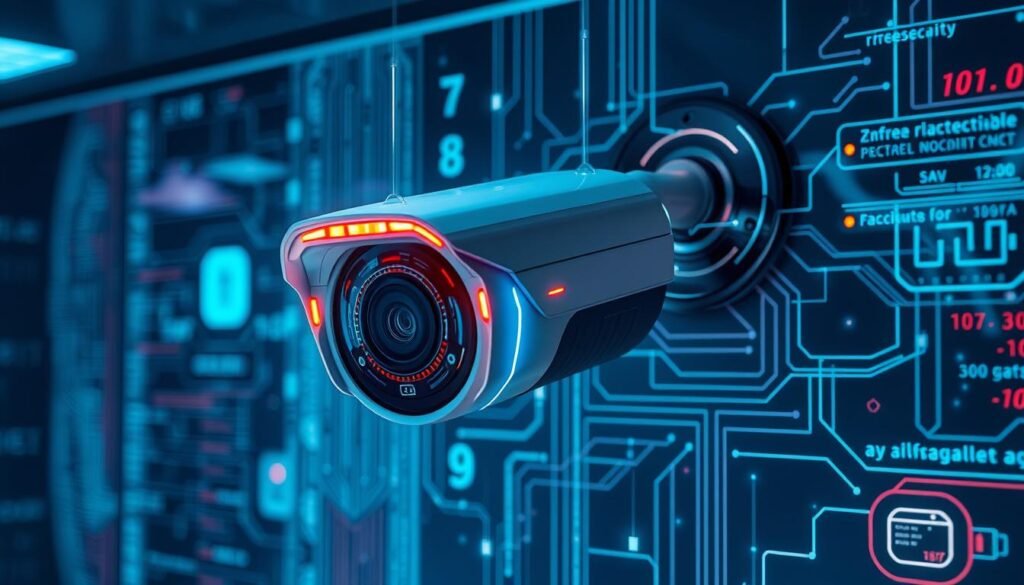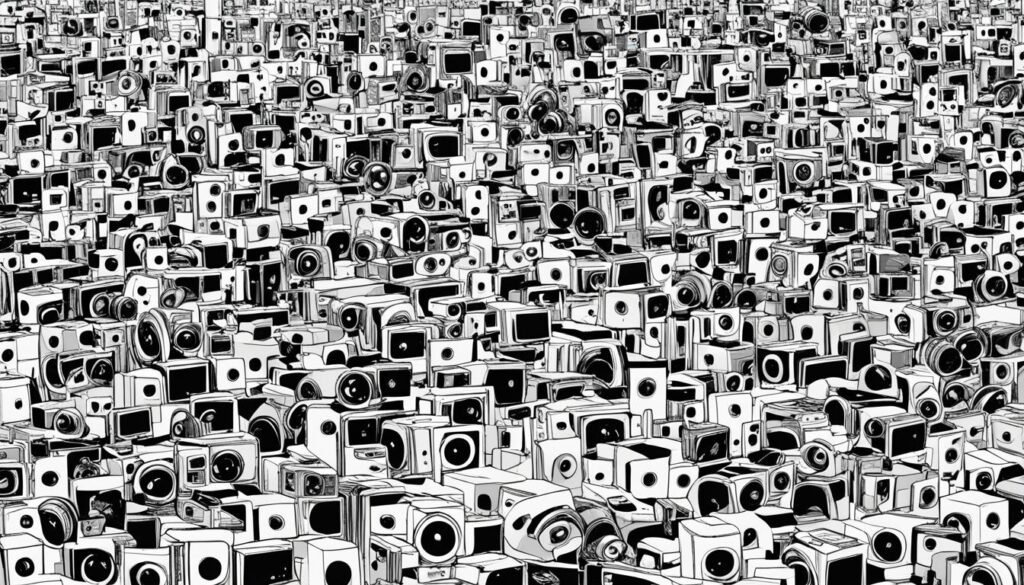Are we moving towards a future where our faces unlock everything? Facial recognition technology is becoming a big part of our lives. It’s not just a theory anymore.
Samsung C&T’s construction division is leading this change in the Raemian Songdo Station Centripole apartment complex. They’re using advanced biometrics and identity verification to change how people live. Now, facial recognition helps control who enters apartments and common areas, blending AI into our daily routines to make things safer and easier.
This new way of living shows how facial recognition is changing our idea of safety. It makes getting into places easier and safer. We’ll look into how this tech is not just changing our homes. It could also change how we think about security in cities.
Understanding Facial Recognition Technology
Facial recognition technology has changed how we secure things. It uses face detection to check who you are. It looks at your face and compares it to a list of known faces.
How Facial Recognition Works
It begins with a camera taking a picture. Then, software spots and looks at your face’s key features. These features turn into a digital signature. This signature is checked against a database to see who you are.
Key Components of Face Detection Systems
Face detection needs a few important parts. High-quality cameras take clear pictures. Advanced software picks out your face’s features. Big databases store and match these signatures. Together, they make fast and correct identification possible.
Evolution of Biometric Technologies
Biometrics have grown a lot. Old systems were slow and not very good. Now, facial recognition is quick and precise. New algorithms make matching faster and more accurate. This progress has made facial recognition useful in many areas, like security and smart homes.
Implementing Facial Recognition Security in Urban Living
The Raemian Songdo Station Centripole project in Incheon’s Yeonsu district is a peek into the future of urban living. It’s set to start in October and will have 2,549 units. This complex will use the latest technology to make living safer and more convenient for everyone.
At the heart of this project are facial recognition entry systems. These systems are found at both apartment entrances and individual units. They make getting in easy for residents by removing the need for keys or cards. This makes living there more secure and easy to use.
This project does more than just watch over the area. It uses AI to manage parking, learning what spots each resident likes. This smart parking helps make daily life easier and uses space better in the complex.
Privacy is a big concern, but the project has a solution. It uses AI cameras that blur faces in public spots in real-time. This shows how advanced security can be balanced with privacy in urban living.
Enhancing Access Control with Facial Recognition
Facial recognition technology is changing how we control access in homes. It works with smart home systems to make entering homes easy and safe. This tech is getting more popular, with the global market expected to hit $74.08 billion by 2028.
Integration with Smart Home Systems
Now, smart homes use facial recognition for better security. People can get into their homes without keys or cards. The system checks who you are and lets you in automatically. It’s a safe and easy way to enter homes, especially in cities.
AI-driven Entry Management for Apartments
AI is changing how apartments are secured. These systems use smart algorithms to check your face against a list of allowed residents. It’s very accurate and can keep up with changes in your look over time. This is a big step up from old key systems, offering both ease and better security.
Voice-activated Controls and Facial Recognition Synergy
Voice commands and facial recognition work together to make access control better. You can tell your home to turn on lights or change settings with your voice. At the same time, facial recognition takes care of who gets in. This mix of tech gives a secure, hands-free experience that’s great for health-focused living. With the growth of 3D cameras, we’ll see even more advanced systems that make homes safer and more comfortable.
Facial Recognition Security in Public Spaces
Facial recognition technology is changing how we keep public spaces safe in the U.S. It uses complex algorithms to quickly check who someone is. This makes it a key tool in public areas.
In cities, facial recognition helps police keep people safe. It can scan crowds and spot threats fast, alerting authorities right away. For example, in smart cities, cameras with AI are getting more common. Now, almost 75% of countries use AI in their surveillance cameras, showing a big shift in how cities secure themselves.
Facial recognition does more than just keep us safe. At transport hubs, it speeds up checking identities, making travel smoother. In malls, it helps stop theft and offers better service to shoppers.
But, facial recognition also brings up privacy worries. To tackle these, some cities look at AI cameras that blur faces automatically. This helps balance security with privacy rights. As this tech gets better, finding the right balance between watching over us and respecting our privacy is a big challenge for leaders and tech experts.
Privacy Concerns and Ethical Considerations
The rise of facial recognition technology has brought up big questions about privacy and ethics. As AI gets more common, companies and groups must find a balance between keeping things safe and respecting people’s rights.
AI Real-Time Mosaic Cameras for Privacy Protection
AI real-time mosaic cameras are a new way to protect privacy. They blur faces automatically, keeping people’s identities safe but still keeping places secure. This shows a smart way to protect rights in a world full of cameras.
Balancing Security and Individual Rights
Using facial recognition raises tough questions about balancing safety with freedom. These systems can make places safer but can also threaten privacy. It’s important to teach people about the risks of AI, like deep fakes. The Ottawa Catholic School Board is doing this by teaching 45,000 students about staying safe online.
Legal Frameworks for Facial Recognition Use
As facial recognition tech gets better, laws need to keep up. Policymakers must make rules that protect privacy but also let tech progress. These rules should cover how data is collected, stored, and used to keep facial recognition ethical.
Advancements in Anti-Spoofing Measures
Biometrics are key in verifying identities, making strong anti-spoofing measures essential. Identity theft and fraud have risen 45 times thanks to deepfakes. This shows how vital using artificial intelligence is for fighting fraud.
The biometrics field is changing fast to fight off complex attacks. Now, anti-spoofing tech uses AI to spot and stop unauthorized tries. It looks at things like face features, whether someone is real, and behavior to check if the user is genuine.
On-device edge AI is a big step forward in keeping biometric data safe. It keeps sensitive info on the device, lowering the chance of cloud breaches. This way, it’s quicker and more private.
AI is key in fighting spoofing attacks. These smart systems can find small signs of fraud, like masks or video replays. Working together, experts, governments, and cybersecurity pros are vital in making and using strong anti-spoofing plans.
Facial Recognition in Smart Parking Solutions
Smart parking solutions are changing how we park our cars. The Raemian Songdo Station Centripole project is a great example. It has 2,549 units and uses AI to make parking easier.
AI-driven parking habit analysis
The AI system learns how people park. It guides them to their favorite spots. This makes parking faster and less stressful, especially in a big complex with 1,024 units.
Optimizing visitor parking experiences
Visitors also get help. The system shows them where to park near their destination. This saves time and makes visits smoother, especially in a large complex.
Integration with surveillance systems
The smart parking links with safety systems. It works with facial recognition at entrances. This keeps the complex safe. The parking area has cameras that blur faces for privacy.
These smart parking solutions do more than just park cars. They make life easier and safer for everyone. As cities grow, we’ll see more of these smart systems in our daily lives.
The Future of Facial Analytics and Emotion Recognition
Facial analytics and emotion recognition are changing our world. They offer new ways to improve security and make things more personal. As biometrics evolve, we’re seeing big changes in how we interact with the world.
Smart homes are now using facial analytics to make life better. They can recognize you and change things like lighting based on how you feel. Or, a car might notice if you’re tired and suggest taking a break. These ideas are becoming real.
Emotion recognition is becoming key in customer service. It helps businesses understand and react to how customers feel right away. This tech could also change healthcare. It might help spot mental health issues early or better manage pain.
Privacy is a big concern as these technologies grow. We need ethical rules to balance security with our rights. The future of facial analytics and emotion recognition looks promising, but we must be careful.
Facial Recognition Security: Enhancing Safety Today
Facial recognition security is changing how we keep safe in cities. This advanced tech is making places more secure and easy to use. The Raemian Songdo Station Centripole project shows how facial recognition works well with other smart tech to make things safer.
By mixing facial recognition with AI for parking, these systems create a strong security net. Voice controls and facial recognition work together for a smooth, safe life. This mix of tech not only boosts security but also makes everyday tasks easier.
As facial recognition tech gets better, it tackles privacy worries with new AI cameras that change faces in real-time. These updates help keep us safe without taking away our rights. With better anti-fake measures, facial recognition is becoming a trusted way to keep us safe in our daily lives.


